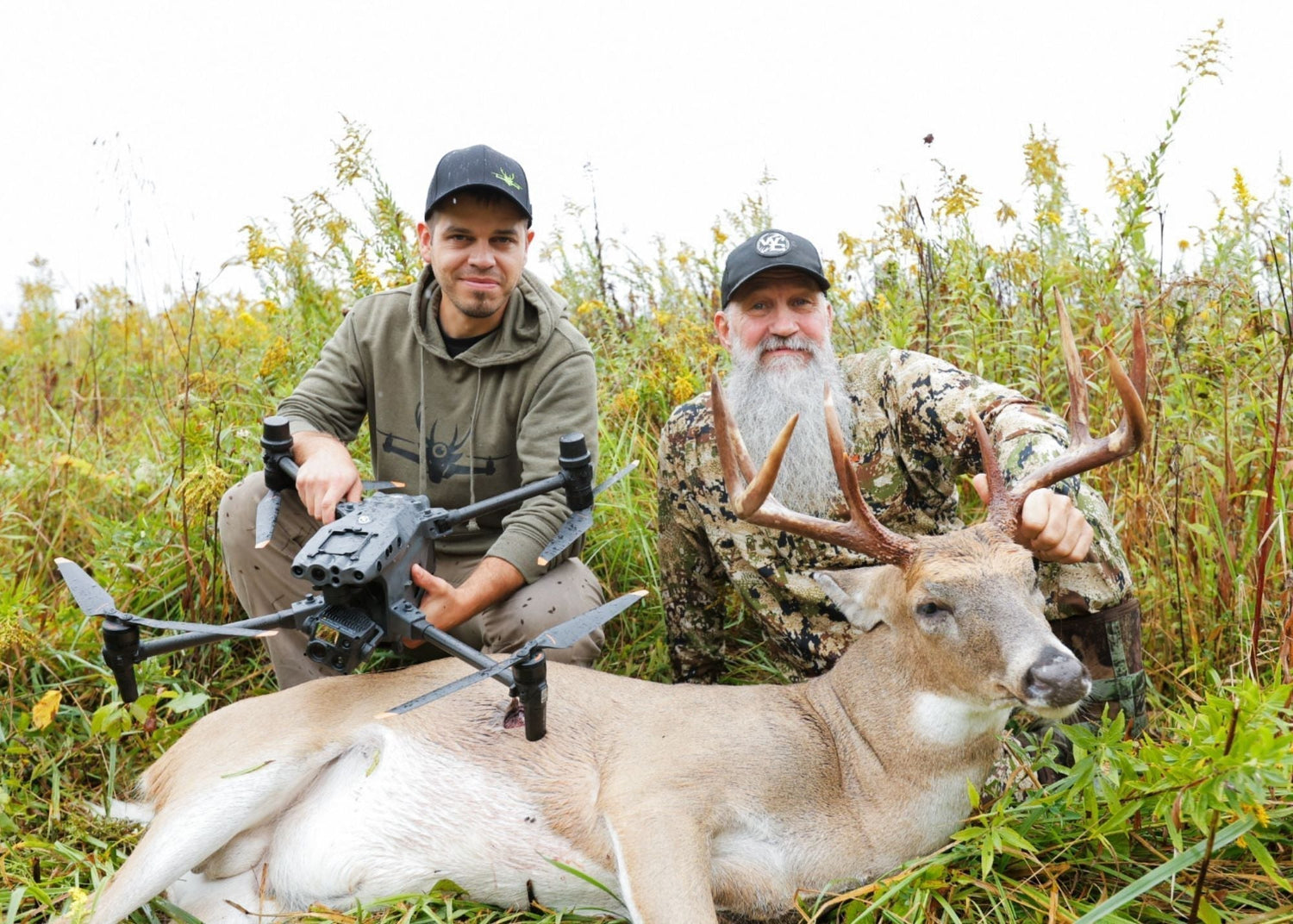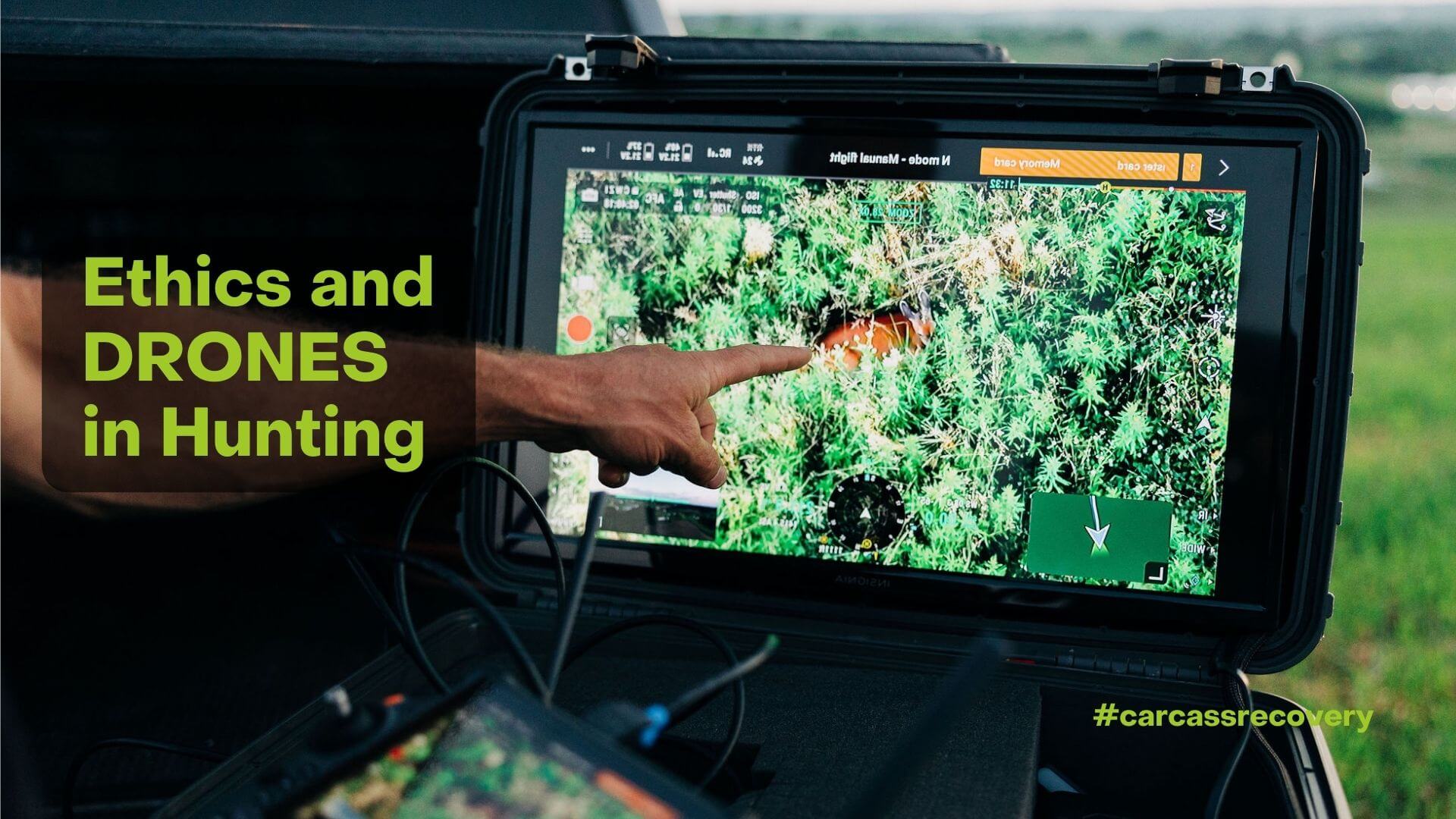Every hunter knows that the skill of tracking is just as crucial as making the shot itself. Unfortunately, tracking a deer after a successful shot can feel like searching for a needle in a haystack as you lose hours of your hunting day painstakingly searching for a wounded deer.
Frustrating, right?
The thrill of the hunt shouldn’t suddenly turn into a long, confusing trek through the woods. This is where technology comes to the rescue—specifically, the use of drones for recovering shot deer.
Before you dismiss drones as gimmicky gadgets for the modern hunter, consider this: You want to make the most of your hunting experience, and new technology like drones can elevate it in remarkable ways.
Drones have become indispensable partners in the woods, aiding hunters in locating and recovering their prey with unprecedented efficiency.

This significantly increases your success rate and makes the post-shot experience more effective and ethical.
At Drone Deer Recovery, we are at the forefront of integrating drone technology into hunting practices, providing hunters with the best equipment and support. With years in the industry, our company knows a thing or two about successful deer recovery strategies, and we’re excited to share that knowledge with you today.
In this blog post, we’re diving into everything you need to know about using drones for deer recovery—how it works, its benefits, and the challenges that come along with it.

The Difficulty of Tracking Shot Deer
Ask any seasoned hunter, and they’ll tell you that tracking a deer is an incredibly demanding task. Even with a perfectly placed shot, a deer can travel a surprising distance before succumbing. The struggle doesn’t end at shooting your mark; instead, it transforms into a new kind of challenge.
Traditional deer tracking methods often involve hours of painstaking work. You’ll likely be trudging through rugged terrain, battling weather conditions, and facing time constraints. This process is physically demanding and emotionally draining, often leading to unsuccessful recovery attempts.
Patience and persistence are key, yet even those have limits. In fact, studies show that as few as 50 percent of hunters successfully recover their deer using traditional methods alone. This is primarily due to factors beyond the hunter’s control, including difficult terrain, weather conditions, poor visibility, and the lack of a visible blood trail.

That’s why many hunters are turning to technology to give them an edge in tracking.
And now, let’s get to the exciting part: how cutting-edge drones are changing the game.
How Does Drone Deer Recovery Work?
Using drones to track and recover deer is relatively new but has quickly gained popularity among hunters looking to improve their tracking efforts. So, how does drone deer recovery work?
1. Pilot:
Hunters begin by contacting a certified drone pilot with a Commercial Drone License issued by the FAA. These pilots use drones equipped with high-definition cameras and, in some cases, thermal imaging capabilities. This allows drones to cover significant expanses of terrain swiftly, reducing the time and effort it takes to locate a downed deer.
2. Flight:
Once airborne, drones perform grid searches over the area where the buck was shot. These drones can survey and capture photographs or videos, providing a bird’s-eye view of the land. Drones equipped with thermal imaging can spot a carcass from 400 feet in the air without disturbing wildlife, even in dense vegetation or challenging light conditions.

This vantage point can help spot the deer faster and more efficiently than walking on foot.
3. Analysis:
After gathering footage, pilots and hunters get exact coordinates to pinpoint the location of their quarry. Thermal drones, particularly during cooler seasons, can quickly spot a heat signature that stands out against the colder background, streamlining the search process.
Using drones blends hunting prowess and modern technology, moving tracking into the 21st century. Now, let’s assess the benefits of incorporating drones into your deer recovery strategy.
Benefits of Using Drones for Recovery of Killed Deer
Not only do drones greatly enhance the recovery process, but they come with an impressive array of benefits. Here’s why more hunters are opting for this tech-forward method:
1. Increased Success Rates:
In challenging tracking conditions, such as dense woods or across rivers and rough terrain, drones increase the likelihood of a successful recovery. They provide hunters with a perspective that’s impossible to achieve from the ground, enabling them to locate animals more reliably.
2. Time-Saving:
Drones significantly reduce the time it takes to find a shot deer. By covering large areas swiftly and accessing hard-to-reach spots, hunters can focus on recovering their game rather than aimlessly searching. Instead of spending hours tracking, hunters can locate the deer in minutes.
3. Reduced Human Impact:
Using drones lessens the environmental disturbance caused by manual tracking. You avoid trampling vegetation or changing natural habitats, promoting more ecologically friendly hunting. Drones can easily access areas inaccessible to humans, ensuring a swift and effective recovery.
4. Ethical Hunting:
Using a drone to quickly locate a wounded deer translates to more ethical hunting, reducing the animal’s suffering and contributing to sustainable hunting.

Drones can quickly and efficiently cover large areas, allowing hunters to find and recover wounded animals more promptly. This minimizes the time an injured deer spends in distress, leading to a more humane outcome.
5. Enhanced Safety:
By deploying a drone, hunters can potentially avoid dangerous situations, such as getting lost in dense forests or accidentally stumbling upon aggressive wildlife. In addition, this means fewer injuries and less potential for exhaustion for the hunter.
The list goes on, underscoring why drones represent a valuable asset in the modern hunter’s toolkit. Yet, as with any significant advancement, accompanying challenges and ethical considerations must be addressed.
Challenges and Ethical Considerations
While the benefits of drone deer recovery are undeniable, it’s essential to weigh them against any challenges and ethical concerns:
1. Regulatory Restrictions:
Not all regions permit drone usage for wildlife tracking and hunting recovery. Hunters should familiarize themselves with local laws and regulations regarding drone operations to avoid legal trouble.
2. Operational Expertise:
Flying a drone requires a certain level of skill and competence. It may involve a learning curve or, depending on jurisdiction, the need for proper licensing. Hiring a certified drone pilot eliminates this challenge for the hunter.
3. Ethical Hunting Practices:
The use of drones shouldn’t negate the challenge or skill involved in hunting. Some argue that drones give hunters an unfair advantage or diminish the traditional skills associated with hunting. Drones should only be used to assist in ethical and efficient recovery. Debate continues within the community about balancing technology with fair chase ethics.
4. Safety:
It is essential to consider the safety of both the animal and the drone operator. Safe operation practices are necessary to prevent any accidents or damage to the equipment or animals.
5. Privacy Issues:
Concerns about privacy on public or private lands can arise, potentially creating friction with other land users. We adhere to strict operational guidelines and respect all privacy laws and regulations, ensuring your use of this technology is both legal and ethical.

For example, we always operate within the specified visual line-of-sight distances and never intrude on private property without explicit permission.
While there are challenges, none are insurmountable. With informed strategies, hunters can incorporate drones responsibly and effectively to enhance their tracking abilities.
Wrapping Up
In the evolving landscape of hunting, drones are proving valuable allies. By providing an aerial advantage, drones are changing the way hunters track and recover their prey. This allows more time to savor the hunt itself and less time to struggle with its aftermath.
Incorporating drones is an exciting step forward for those looking to keep up with modern hunting innovations. It offers significant time savings, higher recovery rates, and promotes more ethical hunting practices. The efficiency and precision of drone technology reduce stress, conserve energy, and allow hunters to focus on the joy of the hunt.

Drone Deer Recovery is revolutionizing the hunting experience. Our expertise in helping hunters ensures you can hunt with confidence and skill. Visit our resources page for additional resources on using drones ethically and information on how drones help with deer herd analysis.
Are you ready to experience the difference? Harness the power of technology to enhance your hunting experience—because out there in the wild, every advantage counts.
Let us help you maximize your success and ensure ethical game recovery. Contact us today to discover how our services can benefit your next hunt.




Leave a comment
This site is protected by hCaptcha and the hCaptcha Privacy Policy and Terms of Service apply.